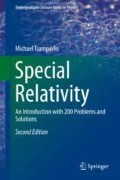Abstract
A tetrad is a set of four linearly independent four-vectors. These vectors can serve as a basis in which one can decompose any other four-vector. If these vectors are orthonormal then the tetrad is called an orthonormal tetrad. Any tetrad whose vectors are non-null can be transformed to an orthonormal tetrad, because one can always choose a Euclidean transformation in SO(3) which will make the three spatial axes orthonormal (plus a dilatation if the original spacelike vectors are not unit). Furthermore if the timelike vector is not normal to the spacelike vectors (equivalently to the spacelike 3-space spanned by these vectors; such tetrads are called tilted tetrads) then by means of a boost one can always define a new timelike vector normal to the 3-surface (just take the projection of the timelike four-vector along the normal to the 3-surface). Subsequently one normalizes the new four-vector to have length − 1 and ends up with an orthonormal tetrad.
Access this chapter
Tax calculation will be finalised at checkout
Purchases are for personal use only
Notes
- 1.
This means that the Lie algebra spanned by the four vectors is the Abelian algebra. Equivalently the tetrad vectors can be written as \(\partial _{x^{i}} \) where x i are coordinate functions.
- 2.
Positive orientation means that the determinant with columns the components of the vectors E (i) i = 0, 1, 2, 3 equals + 1.
- 3.
Future pointing means that the zero component is positive. Under the action of a proper Lorentz transformation remains positive.
- 4.
J.L. Synge (1965) “Relativity: The Special Theory” North Holland Amsterdam p. 94.
- 5.
J.L. Synge was a man devoted to Geometry! And Geometry is in close terms with “symmetry” and “esoteric” simplicity, terms that only true geometers understand!.
- 6.
G. R. Allcock “Synge’s triads of null rays” (1980) Am. J. Phys. 48, 410 – 41.
- 7.
Proof:
Suppose that in a RIO Σ the \(A^{a}=\left ( \begin {array}{c} A^{0} \\ A^{0}\hat {\mathbf {A}} \end {array} \right ) _{\Sigma },B^{a}=\left ( \begin {array}{c} B^{0} \\ B^{0}\hat {\mathbf {B}} \end {array} \right ) _{\Sigma }\) where A 0, B 0 > 0 (because they are future directed). Then
$$\displaystyle \begin{aligned} A^{a}B_{a}=A^{0}B^{0}(-1+\hat{\mathbf{A}}\cdot \hat{\mathbf{B}})=-A^{0}B^{0}(1-\cos \theta )<0. \end{aligned}$$ - 8.
This assumption does not restrict the generality of the results.
- 9.
Proof
$$\displaystyle \begin{aligned} L_{a}L^{a}& =\eta^{abcd} \eta_{arst} I_{b}J_{c}K_{d}I^{r}J^{s}K^{t} \\ & =-\left( \delta _{r}^{b}\delta _{s}^{c}\delta _{t}^{d}-\delta _{r}^{b}\delta _{s}^{d}\delta _{t}^{c}+\delta _{r}^{c}\delta _{s}^{d}\delta _{t}^{b}-\delta _{r}^{c}\delta _{s}^{b}\delta _{t}^{d}+\delta _{r}^{d}\delta _{s}^{b}\delta _{t}^{c}-\delta _{r}^{d}\delta _{s}^{c}\delta _{t}^{b}\right) I^{r}J^{s}K^{t}I_{b}J_{c}K_{d} \\ & = - \delta_{r}^{b}\delta_{s}^{c} \delta_{t}^{d} I^{r}J^{s}K^{t}I_{b}J_{c}K_{d} = 1. \end{aligned} $$ - 10.
ib.
- 11.
For example for the angle \(\theta _{A_{\bot }B_{\bot }}\) we have
$$\displaystyle \begin{aligned} A_{\bot }^{a}.B_{\bot }^{a}{=}\frac{1}{9}(2A_{a}{-}B_{a}{-}C_{a})\cdot (2B_{a}{-}C_{a}{-}A_{a}) {=} \frac{1}{9} \left[ 4(AB){-}2(AC){+}(BC){+}(AB){-}2(BC){+}(AC) \right] {=} {-} \frac{1}{3} \end{aligned}$$$$\displaystyle \begin{aligned} \cos \theta _{A_{\bot }B_{\bot }}{=}\frac{A_{\bot }^{a}.B_{\bot }^{a}}{A_{\bot }B_{\bot }}{=}\frac{{-}\frac{1}{3}}{\left( \frac{\sqrt{6}}{3}\right) ^{2}}{=}{-} \frac{1}{2} \end{aligned}$$ - 12.
This was expected. Why?
- 13.
The calculation of the length has as follows
$$\displaystyle \begin{aligned} L_{(1)a}L_{(1)}^{a}& =\frac{1}{2}\eta^{abcd}\eta_{arst} A_{b}B_{c}C_{d}A^{r}B^{s}C^{t} \\ & =-\frac{1}{2}\left( \delta _{r}^{b}\delta _{s}^{c}\delta _{t}^{d}-\delta _{r}^{b}\delta _{s}^{d}\delta _{t}^{c}+\delta _{r}^{c}\delta _{s}^{d}\delta _{t}^{b}-\delta _{r}^{c}\delta _{s}^{b}\delta _{t}^{d}+\delta _{r}^{d}\delta _{s}^{b}\delta _{t}^{c}-\delta _{r}^{d}\delta _{s}^{c}\delta _{t}^{b}\right) A_{b}B_{c}C_{d}A^{r}B^{s}C^{t} \\ & =-\frac{1}{2}\left( \delta _{r}^{c}\delta _{s}^{d}\delta _{t}^{b}+\delta _{r}^{d}\delta _{s}^{b}\delta _{t}^{c}\right) A_{b}B_{c}C_{d}A^{r}B^{s}C^{t} \\ & =-\frac{1}{2}\left[ (BA)(CB)(AC)+(CA)(AB)(BC)\right] \\ & =1. \end{aligned} $$ - 14.
The fact that such a null vector l a exists is based on the property that “Every proper orthochronous Lorentz transformation leaves at least one null direction invariant”. The proof of this statement is as follows. \(L_{+}^{\uparrow }\) maps the future light cone onto itself and thus generates a continuous mapping of the unit sphere onto itself (which does not change the orientation of the closed curves on the sphere). According to the fixed point theorem of Browner there is always at least one point of the sphere which remains fixed under such a mapping, and the null direction which corresponds to this point is left invariant under the action of the transformation \(L_{+}^{\uparrow }.\)
- 15.
More information on the null rotations can be found in early papers such as. 1. R.K.Sachs Proc. Roy. Soc. (London) (1961),264, 369; 2. H. Bondi, F.A.E. Pirani and I. Robinson Proc. Poy. Soc. (London) (1959), A251, 519; S. Bazanski J. Math Phys. (1965), 6, 1201.
- 16.
A bivector which satisfies this property is called a null bivector.
Author information
Authors and Affiliations
Rights and permissions
Copyright information
© 2019 Springer Nature Switzerland AG
About this chapter
Cite this chapter
Tsamparlis, M. (2019). Null Triads and Proper Lorentz Transformation. In: Special Relativity. Undergraduate Lecture Notes in Physics. Springer, Cham. https://doi.org/10.1007/978-3-030-27347-7_16
Download citation
DOI: https://doi.org/10.1007/978-3-030-27347-7_16
Published:
Publisher Name: Springer, Cham
Print ISBN: 978-3-030-27346-0
Online ISBN: 978-3-030-27347-7
eBook Packages: Physics and AstronomyPhysics and Astronomy (R0)

